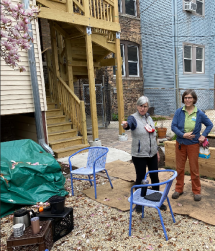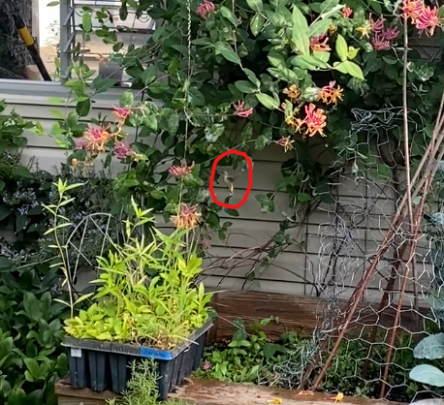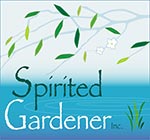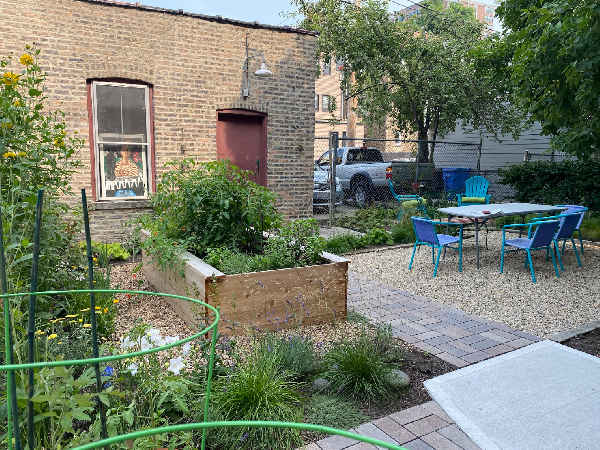Spirited Gardener: Cultivating More Than Just Gardens
"Nature holds the key to our aesthetic, intellectual, cognitive and even spiritual satisfaction." E.O. Wilson. This resonates deeply with our approach. Every project is an opportunity to learn from the land and create something truly special.
At Spirited Gardener, we believe in fostering a deeper connection with nature through our work. It's not just about planting beautiful gardens; it's about creating spaces that nourish the soul and harmonize with the environment. This philosophy is embodied in our four core values: Communication, Collaboration, Connection, and Creativity.
The 4 Cs of a Spirited Gardener
1. Communication: Open and honest communication is the foundation of any successful project. We prioritize face-to-face conversations with our clients, ensuring we understand their vision, needs, and expectations every step of the way. This includes clear communication about the process, from initial design to ongoing maintenance, ensuring complete transparency and customer satisfaction.
2. Collaboration: We work with nature, not against it. This means embracing natural processes and finding solutions that benefit both the landscape and its inhabitants. Examples include:

Over a decade ago, I stood in a flooded backyard, witnessing both vulnerability and new life: a doe with her newborn twins, hidden in poison ivy. The homeowners sought solutions for seasonal flooding, and I saw the potential for native plants to restore balance. I shared my connection to the land's beauty with them, envisioning a solution that worked with nature.
In my enthusiasm to collaborate with nature, I neglected to fully collaborate with the homeowners. Specifically, I failed to gauge their tolerance for any standing water. While I addressed the summer mosquito issue, their fear of flooding, of their home being threatened, overshadowed any success. The spring overflow, though temporary and manageable in my eyes, was unacceptable to them.
Looking back, I realize my approach was incomplete. I could have asked more direct questions and involved both homeowners about their expectations and fears. While nature offers solutions, the homeowners ultimately dictate the terms of their space. Had I possessed the experience I have now, I would have recommended a large underground cistern to manage the excess water, coupled with the native plantings. That experience taught me the vital importance of client communication, understanding the land's rhythms, and continuous learning.
Looking at Your Landscape Through an Eco-Functional Lens
Spirited Gardener believes in creating landscapes that are not only beautiful but also functional within the ecosystem. This means:
____________________________________________________________________________________________________________________________________
Eco(Fun) Fact: Hummingbirds are Coming!
Spring and summer are the perfect time to invite nature’s most vibrant little visitors into your garden: hummingbirds! These tiny, iridescent creatures are not only a joy to watch, but they also play a vital role in pollination. In the Chicagoland area, hummingbirds typically begin arriving in late April to early May, staying through the summer and often leaving in September or October as they migrate south for the winter. The most common species you’ll see in Illinois is the Ruby-throated Hummingbird, known for its striking iridescent green feathers and the brilliant ruby-red throat of the male.
Hummingbird In Evanston Garden Video: IMG_5860.MOV
 Creating a hummingbird-friendly garden starts with choosing native plants that offer both nectar and shelter. Native plants are adapted to local conditions, making them more resilient and beneficial for local wildlife, including hummingbirds.Great Native Plants for Hummingbirds in Chicagoland
Creating a hummingbird-friendly garden starts with choosing native plants that offer both nectar and shelter. Native plants are adapted to local conditions, making them more resilient and beneficial for local wildlife, including hummingbirds.Great Native Plants for Hummingbirds in Chicagoland
Eco Fun Fact: Did you know that hummingbirds can visit up to 1,000 flowers in a single day? With so many flowers to choose from, planting native nectar-rich species helps provide them with the energy they need for their high metabolism and long migratory journeys.
Credits: Nectar-rich Natives for Hummingbirds - Grow Native!; AttractingHummingbirdsFS-1046April2015.pdf
At Spirited Gardener, we believe in fostering a deeper connection with nature through our work. It's not just about planting beautiful gardens; it's about creating spaces that nourish the soul and harmonize with the environment. This philosophy is embodied in our four core values: Communication, Collaboration, Connection, and Creativity.
The 4 Cs of a Spirited Gardener
1. Communication: Open and honest communication is the foundation of any successful project. We prioritize face-to-face conversations with our clients, ensuring we understand their vision, needs, and expectations every step of the way. This includes clear communication about the process, from initial design to ongoing maintenance, ensuring complete transparency and customer satisfaction.
2. Collaboration: We work with nature, not against it. This means embracing natural processes and finding solutions that benefit both the landscape and its inhabitants. Examples include:
- Conscious weeding: Prioritizing the removal of invasive species while preserving beneficial native groundcovers.
- Adaptive planting: Allowing for natural plant movement and succession over time, recognizing that a garden is a dynamic ecosystem.
- Natural solutions: Utilizing beneficial nematodes for pest control instead of harsh chemicals.

- Client connection: Building strong relationships with our clients, understanding their unique needs, and collaborating closely throughout the entire process (picture to the left).
- Nature connection: Designing landscapes that foster a deeper appreciation for the natural world, its rhythms, and its beauty.
- Personal connection: Encouraging our team members to express their individual passions and connect with nature through their work.
- Living fences: I
ncorporating native sunflowers or grasses (like the work we did for a client in the picture on the left) are just one example to create beautiful and functional barriers. Evergreen shrubs and shrub borders can provide more permanent boundaries.
- Artistic rain gardens: Designing aesthetically pleasing rain gardens with strategically placed rocks to guide water flow.
- Personal expression: Encouraging our team members to explore their artistic talents, whether it's through poetry, painting, or other forms of expression inspired by nature.
Over a decade ago, I stood in a flooded backyard, witnessing both vulnerability and new life: a doe with her newborn twins, hidden in poison ivy. The homeowners sought solutions for seasonal flooding, and I saw the potential for native plants to restore balance. I shared my connection to the land's beauty with them, envisioning a solution that worked with nature.
In my enthusiasm to collaborate with nature, I neglected to fully collaborate with the homeowners. Specifically, I failed to gauge their tolerance for any standing water. While I addressed the summer mosquito issue, their fear of flooding, of their home being threatened, overshadowed any success. The spring overflow, though temporary and manageable in my eyes, was unacceptable to them.
Looking back, I realize my approach was incomplete. I could have asked more direct questions and involved both homeowners about their expectations and fears. While nature offers solutions, the homeowners ultimately dictate the terms of their space. Had I possessed the experience I have now, I would have recommended a large underground cistern to manage the excess water, coupled with the native plantings. That experience taught me the vital importance of client communication, understanding the land's rhythms, and continuous learning.
Looking at Your Landscape Through an Eco-Functional Lens
Spirited Gardener believes in creating landscapes that are not only beautiful but also functional within the ecosystem. This means:
- Utilizing water wisely: Implementing rain gardens, bioswales, and other features to capture and manage stormwater runoff.
- Building living soil: Prioritizing soil health through composting, mulching, and avoiding harmful chemicals.
- Planting regionally appropriate plants: Selecting native plants that are adapted to our local climate and provide essential habitat for wildlife.
- Food security: When we grow and share food with our neighbors, we can see the source of our nourishment and this grows our confidence in the security of our natural world as Robin Wall Kimmerer says in “The Serviceberry”. We work with clients to build food gardens (like the one seen in the picture on the left).
____________________________________________________________________________________________________________________________________
Eco(Fun) Fact: Hummingbirds are Coming!
Spring and summer are the perfect time to invite nature’s most vibrant little visitors into your garden: hummingbirds! These tiny, iridescent creatures are not only a joy to watch, but they also play a vital role in pollination. In the Chicagoland area, hummingbirds typically begin arriving in late April to early May, staying through the summer and often leaving in September or October as they migrate south for the winter. The most common species you’ll see in Illinois is the Ruby-throated Hummingbird, known for its striking iridescent green feathers and the brilliant ruby-red throat of the male.
Hummingbird In Evanston Garden Video: IMG_5860.MOV
 Creating a hummingbird-friendly garden starts with choosing native plants that offer both nectar and shelter. Native plants are adapted to local conditions, making them more resilient and beneficial for local wildlife, including hummingbirds.Great Native Plants for Hummingbirds in Chicagoland
Creating a hummingbird-friendly garden starts with choosing native plants that offer both nectar and shelter. Native plants are adapted to local conditions, making them more resilient and beneficial for local wildlife, including hummingbirds.Great Native Plants for Hummingbirds in Chicagoland- Bee Balm (Monarda didyma): With its vibrant red, pink, and purple flowers, bee balm is a magnet for both hummingbirds and pollinators like bees. It thrives in full sun to partial shade and adds a splash of color to your garden.
- Wild Columbine (Aquilegia canadensis): Native to the Midwest, this plant features beautiful red and yellow flowers, which are particularly suited to the long bills of hummingbirds. It also does well in woodland settings or partial shade.
- Cardinal Flower (Lobelia cardinalis): Known for its striking red blooms, this plant thrives in moist, sunny spots and is a magnet for hummingbirds in the summer. It also adds vertical interest to your garden design.
- Trumpet Vine/Creeper (Campsis radicans): Known for its large, trumpet-shaped flowers, this plant is a hummingbird favorite. Its bright orange-red blooms are a beacon for these tiny birds in search of nectar.
Eco Fun Fact: Did you know that hummingbirds can visit up to 1,000 flowers in a single day? With so many flowers to choose from, planting native nectar-rich species helps provide them with the energy they need for their high metabolism and long migratory journeys.
Credits: Nectar-rich Natives for Hummingbirds - Grow Native!; AttractingHummingbirdsFS-1046April2015.pdf





